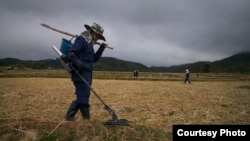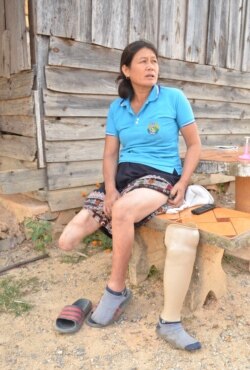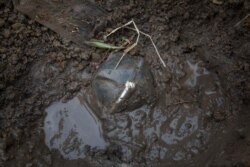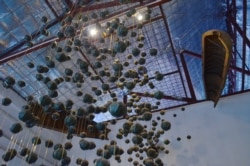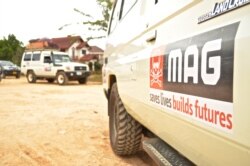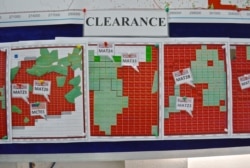It was March 2, 2014, a bright, sunny day, Bou Kham recalled, when a U.S. bomb dropped on Laos more than four decades earlier tore her right leg in half.
She and her two sons were scouring a rice field near their village in the northern Lao province of Xiangkhouang for the cluster bombs that the U.S. had showered on the country during the Vietnam War. They planned to salvage the valuable metal and sell it to the two Vietnamese men who had gone with them.
"I had been doing it for 10 years; the whole village collected the metal for the Vietnamese," she told VOA, holding up her hand in a loose fist to imitate the tiny round bombs, about the size of a tennis ball.
While placing the bombs into a plastic bag on that day, though, one of them hit another and exploded by her feet. The burning shrapnel shot through her leg, pierced one son in the chest and the other in the eye, and killed one of the Vietnamese men on the spot.
"After the explosion I saw my leg was gone and I called to my husband. The next thing I remember I was in the hospital," she said.
Tens of millions of 'bomblets'
On a visit to Laos in 2016, then-U.S. President Barack Obama pledged an additional $90 million toward America's "moral obligation" to help rid Laos of the unexploded ordnance — often referred to as UXO — left behind from the 2 million tons of bombs the U.S. dropped on the tiny country from 1964 to 1973. Half the money was for the first detailed nationwide survey Laos has ever had of the lingering contamination.
The United Nations recently granted Laos an extension on the 2020 target the country had agreed to meet under the Convention on Cluster Munitions to clear all the bombs, taking it to 2025. The Lao government has set its own goal of 2030, but some experts say there's no telling how much longer the work will take.
"It's the most popular question we get is, 'When will it all be cleared,' but, of course, how long is a piece of string, right? Everything is subject to funding," said Sarah Goring, country program officer for the British-based Mines Advisory Group, which runs the largest clearance operation in Laos after the government.
The U.N. pushed back its target date for Laos to 2025 because it only grants five-year extensions, Goring said.
"I don't think anyone thinks that's realistic, because of the extent of the contamination," she added.
In its pursuit of North Vietnamese forces along the Ho Chi Minh Trail and the indigenous communist Pathet Lao, who ultimately won the country's civil war in 1975, the U.S. turned Laos into the most heavily bombed country per capita in the world. Its weapon of choice was the cluster bomb, designed to split open in mid-air to release hundreds of smaller "bomblets," like the one that injured Bou five years ago.
About 1 in 3 of the bomblets — tens of millions of them in all — are believed to have failed to explode on impact. Estimates of how much land they covered vary wildly. The Lao government says 8,000 square kilometers. The Mines Advisory Group says "at least" 2,000 square kilometers.
"I think the reality is it's somewhere in between," said Goring. "No one really knows."
The nationwide "technical survey" that Obama pledged half the $90 million to in 2016 should help them find out. The U.S. has been spreading the money among several contractors.
Technical survey
Most contamination surveys carried out in Laos so far have been of the "nontechnical" sort, drawing heavily on accident reports and the word of local residents. The lack of precision has meant that much time and money has been spent carefully sweeping areas that turned out to have few, if any, bombs.
With a technical survey, teams confirm the contamination exists with an initial, partial sweep of a suspected site before getting down to the work of actually clearing it. The Mines Advisory Group and others were doing technical surveys in Laos before 2016; the U.S. infusion of cash that year has helped them scale up.
"It helps because it makes the process faster," the Mines Advisory Group's technical field manager in Xiangkhouang, Perparim Elezi, said of the technical surveys. "We know exactly where there is no contamination and where there is contamination."
Elezi, an ex-soldier from Kosovo with more than 20 years of experience clearing mines and UXO, said a technical survey of all of Laos could be done by 2025. He saw little chance of ridding the country of UXO by then, and said 2030 also looked like a long shot but added, "never say never."
As of July, the government and contractors had cleared 600 square kilometers of Laos since 1996, when official records began — only about a third of the Mines Advisory Group's lowest estimate of the area the U.S. bombing contaminated.
Living in fear
The pace of work is picking up, though, thanks to improving techniques and technology, as well as more funding from the U.S. and others. The 62 square kilometers cleared in 2018 was nearly double what was cleared in 2008.
Meanwhile, because more land is being made safe, and because of growing public awareness of the risks old bombs still pose, casualties are down. UXO killed three people and injured 21 in 2018; In 2008, they killed 99 and injured 203.
COPE, a Lao charity that provides the disabled with rehabilitation and prosthetic limbs, is serving ever fewer new UXO victims each year.
Its CEO, Bounlanh Phayboun, said she is grateful for the new funding speeding up the technical survey work, but frustrated that it took so long to arrive.
"Of course it's disappointing, because it [did] start too late, after 40 years," she said.
Thousands of villagers continue to live in fear of the bombs literally buried and hidden under their feet, Bounlanh said, forced by poverty and a lack of options to work the land they have even when they know the risks.
"This year you use it, it's safe," she said. "But [the] coming year or [in] two years ... you can hit it any time."




